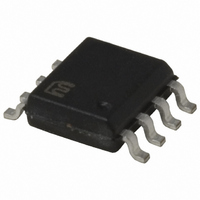MIC5013BM Micrel Inc, MIC5013BM Datasheet - Page 9

MIC5013BM
Manufacturer Part Number
MIC5013BM
Description
IC DRIVER MOSF HI/LO SIDE 8SOIC
Manufacturer
Micrel Inc
Datasheet
1.MIC5013YM.pdf
(15 pages)
Specifications of MIC5013BM
Configuration
High or Low Side
Input Type
Non-Inverting
Delay Time
60µs
Number Of Configurations
1
Number Of Outputs
1
Voltage - Supply
7 V ~ 32 V
Operating Temperature
-40°C ~ 85°C
Mounting Type
Surface Mount
Package / Case
8-SOIC (3.9mm Width)
Number Of Drivers
1
Driver Type
High Side/Low Side
Operating Supply Voltage (max)
32V
Power Dissipation
1.25W
Operating Supply Voltage (min)
7V
Operating Supply Voltage (typ)
15V
Turn Off Delay Time
4us
Turn On Delay Time (max)
60us
Operating Temp Range
-40C to 85C
Operating Temperature Classification
Industrial
Mounting
Surface Mount
Pin Count
8
Package Type
SOIC
Lead Free Status / RoHS Status
Contains lead / RoHS non-compliant
Current - Peak
-
High Side Voltage - Max (bootstrap)
-
Lead Free Status / Rohs Status
Not Compliant
Available stocks
Company
Part Number
Manufacturer
Quantity
Price
Part Number:
MIC5013BM
Manufacturer:
MICREL
Quantity:
20 000
Company:
Part Number:
MIC5013BM/YM
Manufacturer:
MICREL
Quantity:
300
R
C
22µF
MIC5013
1kΩ
TH2
TH
Applications Information
(using TAB and SOURCE for forcing, and SENSE and
KELVIN for sensing) is the best method of evaluating “R.”
Alternatively, “R” can be estimated for large MOSFETs
(R
or by subtracting 20 to 50mΩ from the stated R
smaller MOSFETs.
High-Side Driver with Current Sensing MOSFET (Figure
5). The design starts by determining the value of “S” and
“R” for the MOSFET (use the guidelines described for the
low-side version). Let V
a desired trip current. Next calculate R
point is somewhat reduced when the output is at ground as
the voltage drop across R1 is zero. No clamping is required
for inductive loads, but may be added to reduce power dis-
sipation in the MOSFET.
Typical Applications
Start-up into a Dead Short. If the MIC5013 attempts to turn
on a MOSFET when the load is shorted, a very high current
flows. The over-current shutdown will protect the MOSFET,
but only after a time delay of 5 to 10µs. The MOSFET must
be capable of handling the overload; consult the device’s
SOA curve. If a short circuit causes the MOSFET to exceed
its 10µs SOA, a small inductance in series with the source
can help limit di/dt to control the peak current during the 5
to 10µs delay.
When testing short-circuit behavior, use a current probe
rated for both the peak current and the high di/dt.
The over-current shutdown delay varies with comparator
overdrive, owing to noise filtering in the comparator. A delay
of up to 100µs can be observed at the threshold of shutdown.
A 20% overdrive reduces the delay to near minimum.
Incandescent Lamps. The cold filament of an incandes-
cent lamp exhibits less than one-tenth as much resistance
as when the filament is hot. The initial turn-on current of
a #6014 lamp is about 70A, tapering to 4.4A after a few
hundred milliseconds. It is unwise to set the over-current
July 2005
Control Input
DS(ON)
≤ 100mΩ) by simply halving the stated R
R
22kΩ
TH1
Figure 5. Time-Variable
Trip Threshold
1
2
3
4
TRIP
Thresh
Source
Input
Sense
MIC5013
= 100mV, and calculate R
Fault
Gate
Gnd
V+
(Continued)
8
7
6
5
3.9kΩ
TH
10µF
R 1
and R1. The trip
+
43Ω
12V
DS(ON)
#6014
IRCZ4 4
DS(ON)
S
for
for
,
9
Control Input
trip point to 70A to accommodate such a load. A “resistive”
short that draws less than 70A could destroy the MOSFET
by allowing sustained, excessive dissipation. If the over-
current trip point is set to less than 70A, the MIC5013 will
not start a cold filament. The solution is to start the lamp
with a high trip point, but reduce this to a reasonable value
after the lamp is hot.
The MIC5013 over-current shutdown circuit is designed to
handle this situation by varying the trip point with time (see
Figure 5). R
viding a current limit of approximately twice that required by
the lamp. R
to approximately 10 times the steady-state lamp current.
The high initial trip point decays away according to a 20ms
time constant contributed by C
with C
results in a very high over-current threshold. As a rule of
thumb design the over-current circuitry in the conventional
manner, then add the R
start-up. Let R
tor that provides the desired time constant working against
R
When the MIC5013 is turned off, the threshold pin (2) ap-
pears as an open circuit, and C
R
constant, and it simulates the thermal response of the fila-
ment. If the lamp is pulse-width modulated, the current limit
will be reduced by the residual charge left in C
Modifying Switching Times. Do not add external capacitors
to the gate to slow down the switching time. Add a resistor
(1kΩ to 51kΩ) in series with the gate of the MOSFET to
achieve this result.
Bootstrapped High-Side Driver (Figure 6). The speed
of a high-side driver can be increased to better than 10µs
by bootstrapping the supply off of the MOSFET source.
This topology can be used where the load is pulse-width
modulated (100Hz to 20kHz), or where it is energized
TH2
TH1
and R
20kΩ
and the internal 1kΩ resistor.
R
TH
TH
working against the internal 1kΩ resistor, but this
TH2
TH2
TH1
1
2
3
4
TH2
Thresh
Source
Input
Sense
. This is much slower than the turn-on time
acts to increase the current limit at turn-on
MIC5013
functions in the conventional manner, pro-
Figure 6. Bootstrapped
= (R
High-Side Driver
Fault
Gate
TH1
Gnd
V+
TH2
÷10)–1kΩ, and choose a capaci-
8
7
6
5
/C
TH
TH
R1=
. R
TH
network to allow for lamp
1N5817
100nF
1mA
V
TH2
is discharged through
+
could be eliminated
100Ω
+
10µF
R 2
7 to 15V
LOAD
TH
MIC5013
Micrel, Inc.
.
1N4001 (2)
IRF540
R
18mΩ
S












